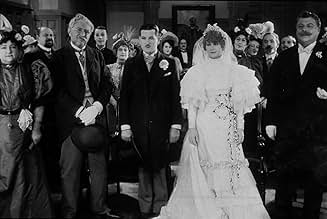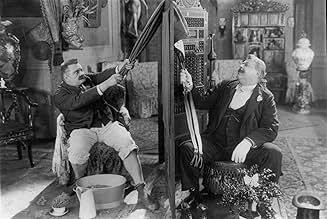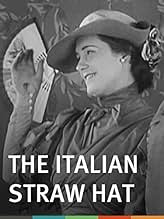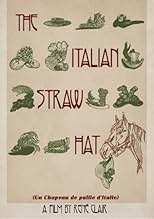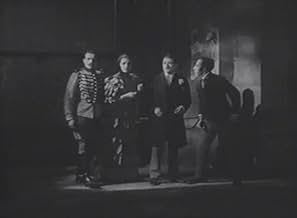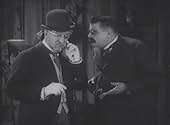Ajouter une intrigue dans votre langueOn his way through the woods to his marriage, Fadinard's horse eats the hat of a married lady spending here a few moments with her lover. Fadinard has to find the very same rare hat to avoid... Tout lireOn his way through the woods to his marriage, Fadinard's horse eats the hat of a married lady spending here a few moments with her lover. Fadinard has to find the very same rare hat to avoid her dishonor. This will greatly disturb his own marriage.On his way through the woods to his marriage, Fadinard's horse eats the hat of a married lady spending here a few moments with her lover. Fadinard has to find the very same rare hat to avoid her dishonor. This will greatly disturb his own marriage.
- Réalisation
- Scénario
- Casting principal
Alice Tissot
- Une cousine
- (as Mme Alice Tissot)
Alexej Bondireff
- Un cousin
- (as M. Alexis Bondi)
Marise Maia
- La mariée
- (as Mlle Maryse Maia)
Yvonneck
- Nonancourt
- (as M. Yvonneck)
Louis Pré Fils
- Cousin Bobin
- (as M. Pré fils)
Albert Préjean
- Fadinard, le marié
- (as M. Albert Préjean)
Geymond Vital
- Le lieutenant Tavernier
- (as M. Vital Geymond)
Olga Tschechowa
- Anaïs de Beauperthuis
- (as Mme Olga Tschekova)
Paul Ollivier
- L'oncle Vézinet
- (as M. Paul Olivier)
Alex Allin
- Félix
- (as M. Alex Allin)
André Volbert
- Le maire
- (as M. Volbert)
Jim Gérald
- Beauperthuis
- (as M. Jim Gérald)
Lya Christy
- Une invitée de la noce
- (as Christie)
Nino Constantini
- Un invité de la noce
- (as Nino Costantini)
A. Debriège
- Une invitée de la noce
- (as Albany Debriège)
Avis à la une
I should point out from the outset that I was probably in the wrong frame of mind for a movie like this. Today was a pretty extreme example of "one of those days" for me. I sat down to watch this, definitely wanting a laugh. But any movie was going to have to work extra hard to get a laugh out of me on this crappy day, and this one didn't really do the job. I should have probably gone with something simple and sure-fire, like a Buster Keaton movie, or a Woody Allen, or a Monty Python. Or maybe I should have just gone for a long bike ride. But I watched this instead.
This is one of those society comedies, with a large cast of characters, and various complicated goings on. Most of the humor derives from people trying to put a normal happy face on for the benefit of society, while meanwhile things are spinning out of control beneath the surface. It reminded me a little bit of Fawlty Towers, with John Cleese, for some reason. It's the same kind of humor. You've probably seen a lot of the gags in 10,000 TV sitcoms by now, but I suppose this stuff was a lot fresher in 1927. And most of it was pretty well done, I'll admit.
The story itself is simple, but you have to pay a lot of attention to keep track of all the moment-to-moment details. And I guess that's where the movie failed for me today. My mind kept wandering, and I'd have to rewind the tape to figure out what was going on, and I'd get annoyed. I was really feeling the lack of dialogue in this one. I watch a lot of silent films. They appeal to me for some reason I can't explain. But this movie felt incomplete to me. I felt it would have worked better as a talkie. But maybe it was just the mood I was in.
Anyway, there were several individual scenes that I thought were brilliant, and definitely made me sit up and take notice. One was worthy of a Seinfeld episode: it's a wedding scene; a woman notices her husband's necktie is undone, and she repeatedly nudges him and fiddles with her neck. The husband takes no notice. He sits there like a lump. But another character instinctively reaches to check his tie. This starts a chain reaction, and pretty soon everyone in the church is checking their ties, except for the husband, who's still sitting there oblivious. Another great scene is when the groom at the wedding imagines the angry military man back at his house, vandalizing everything, tossing all his possessions out the windows, tearing down walls--the film lapses into total surrealism; this is Rene Clair at his visual best. I love this scene.
For now, I'm going to rate this a 7/10. But I'll try to catch it again some day, when I'm in a better and more attentive mood, and I think I'll like it a lot better.
This is one of those society comedies, with a large cast of characters, and various complicated goings on. Most of the humor derives from people trying to put a normal happy face on for the benefit of society, while meanwhile things are spinning out of control beneath the surface. It reminded me a little bit of Fawlty Towers, with John Cleese, for some reason. It's the same kind of humor. You've probably seen a lot of the gags in 10,000 TV sitcoms by now, but I suppose this stuff was a lot fresher in 1927. And most of it was pretty well done, I'll admit.
The story itself is simple, but you have to pay a lot of attention to keep track of all the moment-to-moment details. And I guess that's where the movie failed for me today. My mind kept wandering, and I'd have to rewind the tape to figure out what was going on, and I'd get annoyed. I was really feeling the lack of dialogue in this one. I watch a lot of silent films. They appeal to me for some reason I can't explain. But this movie felt incomplete to me. I felt it would have worked better as a talkie. But maybe it was just the mood I was in.
Anyway, there were several individual scenes that I thought were brilliant, and definitely made me sit up and take notice. One was worthy of a Seinfeld episode: it's a wedding scene; a woman notices her husband's necktie is undone, and she repeatedly nudges him and fiddles with her neck. The husband takes no notice. He sits there like a lump. But another character instinctively reaches to check his tie. This starts a chain reaction, and pretty soon everyone in the church is checking their ties, except for the husband, who's still sitting there oblivious. Another great scene is when the groom at the wedding imagines the angry military man back at his house, vandalizing everything, tossing all his possessions out the windows, tearing down walls--the film lapses into total surrealism; this is Rene Clair at his visual best. I love this scene.
For now, I'm going to rate this a 7/10. But I'll try to catch it again some day, when I'm in a better and more attentive mood, and I think I'll like it a lot better.
Report from Cinesation 2006: AN Italian STRAW HAT (***) Rene Clair had a huge reputation in the early days of sound, and though it's not hard to see why, it is hard to see why the same critics who loved his films (often voting them onto the early Sight & Sound lists of the best films of all time) were dismissive of great Hollywood comedies with exactly the same virtues. (A Nous la Liberte and Le Million are delightful, for instance, but in no way that Duck Soup and Top Hat aren't equally or more delightful.)
This-- based on a perennial stage farce about the complications that follow when a horse eats a married woman's hat while she's off dallying with her lover-- is skillful enough, and it has a few very funny moments, but made mostly in medium or longshot with little subtlety in the playing, it seemed far more primitive for 1927 than, to pick one American comedy, Kiki (shown earlier the same day)-- and the audience at Cinesation didn't laugh nearly as often, either.
This-- based on a perennial stage farce about the complications that follow when a horse eats a married woman's hat while she's off dallying with her lover-- is skillful enough, and it has a few very funny moments, but made mostly in medium or longshot with little subtlety in the playing, it seemed far more primitive for 1927 than, to pick one American comedy, Kiki (shown earlier the same day)-- and the audience at Cinesation didn't laugh nearly as often, either.
Silent film fans are really in for a treat with this DVD. Once again, Flicker Alley has released a terrific DVD--with a nearly pristine print (very rare for a silent), some nice special features as well as two different sound tracks for this movie! Each time I see one of their films, I marvel at the amazing care they give each release--and it's the class of the industry.
"The Italian Straw Hat" is film that was a bit short on plot but is still well worth seeing. This is because the director, René Clair, did a masterful job with this movie--with great camera-work and composition throughout. Unfortunately, despite looking great the plot keeps me from giving the movie an even higher score. The problem is that although the story is entertaining, it just had too many holes--too many situations that simply were too hard to believe and could have EASILY been resolved...but weren't.
The film begins with a bridegroom traveling by horse and buggy to his wedding. On the way, he gets out and his horse keeps walking--and finds a straw hat that it begins to eat! Naturally, the lady who owned the hat was angry and her lover was ready to fight. The bridegroom tried to pay for it but the couple insisted he find a replacement hat. And, they follow him into town and continue to insist--even moving into his apartment and threatening to destroy the place unless he get an identical hat. It turns out it's because the woman is married to a different man and doesn't want to have to explain to him what happened to the hat. But why the couple squatted for many hours in the house seemed forced--and why the bridegroom didn't just go to the police made no sense either. But, it did have lots of cute and mildly funny moments--even if the story just made no sense.
Overall, the film is expertly filmed but inconsequential because of the writing. It's worth seeing if you love silents or if you want to see a silent that manages to have very, very few intertitle cards yet tells the story very well. Otherwise, there are better silents out there--even with the great Flicker Alley package.
"The Italian Straw Hat" is film that was a bit short on plot but is still well worth seeing. This is because the director, René Clair, did a masterful job with this movie--with great camera-work and composition throughout. Unfortunately, despite looking great the plot keeps me from giving the movie an even higher score. The problem is that although the story is entertaining, it just had too many holes--too many situations that simply were too hard to believe and could have EASILY been resolved...but weren't.
The film begins with a bridegroom traveling by horse and buggy to his wedding. On the way, he gets out and his horse keeps walking--and finds a straw hat that it begins to eat! Naturally, the lady who owned the hat was angry and her lover was ready to fight. The bridegroom tried to pay for it but the couple insisted he find a replacement hat. And, they follow him into town and continue to insist--even moving into his apartment and threatening to destroy the place unless he get an identical hat. It turns out it's because the woman is married to a different man and doesn't want to have to explain to him what happened to the hat. But why the couple squatted for many hours in the house seemed forced--and why the bridegroom didn't just go to the police made no sense either. But, it did have lots of cute and mildly funny moments--even if the story just made no sense.
Overall, the film is expertly filmed but inconsequential because of the writing. It's worth seeing if you love silents or if you want to see a silent that manages to have very, very few intertitle cards yet tells the story very well. Otherwise, there are better silents out there--even with the great Flicker Alley package.
I have to confess that I was left bemused by the warm, not to say rapturous, audience comments I overheard when leaving the cinema. I can easily credit that it benefits from a live accompaniment rather than whatever music was applied to the soundtrack on a home video release -- but I found the pacing of the film slow and verging on funereal, the plot a strained farce revolving around a comedy of 19th-century manners already outdated in the 1920s, and the characters so unsympathetic that I caught myself feeling gratified when it looked as if the seething husband was about to blow the deception wide open. There were times when I was in sympathy with the gentleman sitting at the end of my row, who intermittently let out choked snores before jerking awake.
The film has its moments, but overall I found it disconcertingly tedious -- shots seem to be repeated and lingered upon beyond humour, and for no clear reason. The opening scenes are a pretty fair sample of the pacing and style throughout, as the various members of the bridal party experience problems in dressing, in a sequence that feels as if it extends a good five minutes: it's mildly amusing, but it's mainly 'situation' comedy in which the characterisations themselves are supposed to be funny rather than anything they actually do, and it goes on and on. Similarly, in the finale, after the plot is unravelled in what seems intended to be the end, a series of half a dozen impressionistic epilogues follow one after another, with no sign of when the film is ever going to stop...
The mechanics of the farce depend on stock characters: the endlessly-fainting lady, the insanely insistent lover, the stone-deaf old man. Gags that are eventually funny -- e.g. the mass adjustment of ties during the civil ceremony -- are built up to via enormous layering and labouring of detail. The idiom is, I suspect, to me a basically alien one; but it's the timing that really hurts as far as entertainment goes. I don't care for slapstick, but this film goes to the opposite extreme -- clearly too sophisticated for my uncultured taste to handle.
The film has its moments, but overall I found it disconcertingly tedious -- shots seem to be repeated and lingered upon beyond humour, and for no clear reason. The opening scenes are a pretty fair sample of the pacing and style throughout, as the various members of the bridal party experience problems in dressing, in a sequence that feels as if it extends a good five minutes: it's mildly amusing, but it's mainly 'situation' comedy in which the characterisations themselves are supposed to be funny rather than anything they actually do, and it goes on and on. Similarly, in the finale, after the plot is unravelled in what seems intended to be the end, a series of half a dozen impressionistic epilogues follow one after another, with no sign of when the film is ever going to stop...
The mechanics of the farce depend on stock characters: the endlessly-fainting lady, the insanely insistent lover, the stone-deaf old man. Gags that are eventually funny -- e.g. the mass adjustment of ties during the civil ceremony -- are built up to via enormous layering and labouring of detail. The idiom is, I suspect, to me a basically alien one; but it's the timing that really hurts as far as entertainment goes. I don't care for slapstick, but this film goes to the opposite extreme -- clearly too sophisticated for my uncultured taste to handle.
I just looked at Rene Clair's "An Italian Straw Hat" for the second time -- the first time in a dozen years and though I am now aware of potential issues with the viewing process -- like most late silent pictures, it almost certainly plays better with an audience -- seeing it by myself on my TV, it again falls a bit flat. The last time it was on a mediocre VHS copy. This time it was on the beautifully transferred Flicker Alley DVD.
This weakness surprised me the first time I saw it, since I am a great fan of Clair's sound films, as well as his silent short subjects, but I think I have identified at least part of the problem: I think Clair was directing under close supervision by someone who expected to see Labiche's play on the screen. As Clair's great films were always surrealistic, clearly in a world disjoint from the one we see around us, how could he be expected to to force the viewer into his own world? Even the way the characters are dressed and shot is typical of early French films -- one of the DVD extras is a Zecca short from 1906 or 1908, ""After the Wedding" and those characters were virtually dropped into Clair's picture -- so at least I now understand that we are dealing with then-current stage conventions.
Most of the movie looks as if it could have been directed by Louis Feullade: it has the placidly sardonic, observant camera, although it lacks the air of emotional reality that Feuillade's seemingly-improvised movies had: some of the wilder parts of LES VAMPIRE look as if he realized he had written himself into a corner, and there's one of his earlier movies in which the characters have to mail a letter, so they take a hot-air balloon to a mail box and I suddenly realized that the producer had given them a balloon and Feuillade used it because it would look cool and it was already paid for.
Albert Préjean, one of Clair's regulars at this point -- he was magnificent in "Sous les Toits de Paris" -- attempts the lead role with an air of depression. Unfortunately, while this may be appropriate to the character, given that he is watching his life unravel, the flat affect of depression is not terribly interesting for the audience.
It is only about two-thirds of the way through that Clair asserts his authority by showing us what's going on in Préjean's mind as houses begin to fall apart. But while this revived my interest, the tight plotting of Labiche's play took over again and I could see the wheels spinning neatly over the tracks of the story.
Ultimately, this is a superior silent version of an excellent 19th Century farce and should keep the dedicated silent enthusiast engrossed. However, for the fan of Rene Clair, it is a bit patchy.
I watched the movie with the Alloy Orchestra's soundtrack playing -- their arrangements are usually solid and supportive. If I enjoy a silent movie, I usually don't consciously notice the soundtrack, so the fact that I think that their polite-sounding orchestrations of late 19th and early 20th century program music is entirely appropriate is a bit of a put-down. It is certainly not their fault that I am familiar with one of the tunes through its use by Allen Sherman for one his comic rewrites: in this case, I kept hearing him singing his sardonic "Lots of Luck."
This weakness surprised me the first time I saw it, since I am a great fan of Clair's sound films, as well as his silent short subjects, but I think I have identified at least part of the problem: I think Clair was directing under close supervision by someone who expected to see Labiche's play on the screen. As Clair's great films were always surrealistic, clearly in a world disjoint from the one we see around us, how could he be expected to to force the viewer into his own world? Even the way the characters are dressed and shot is typical of early French films -- one of the DVD extras is a Zecca short from 1906 or 1908, ""After the Wedding" and those characters were virtually dropped into Clair's picture -- so at least I now understand that we are dealing with then-current stage conventions.
Most of the movie looks as if it could have been directed by Louis Feullade: it has the placidly sardonic, observant camera, although it lacks the air of emotional reality that Feuillade's seemingly-improvised movies had: some of the wilder parts of LES VAMPIRE look as if he realized he had written himself into a corner, and there's one of his earlier movies in which the characters have to mail a letter, so they take a hot-air balloon to a mail box and I suddenly realized that the producer had given them a balloon and Feuillade used it because it would look cool and it was already paid for.
Albert Préjean, one of Clair's regulars at this point -- he was magnificent in "Sous les Toits de Paris" -- attempts the lead role with an air of depression. Unfortunately, while this may be appropriate to the character, given that he is watching his life unravel, the flat affect of depression is not terribly interesting for the audience.
It is only about two-thirds of the way through that Clair asserts his authority by showing us what's going on in Préjean's mind as houses begin to fall apart. But while this revived my interest, the tight plotting of Labiche's play took over again and I could see the wheels spinning neatly over the tracks of the story.
Ultimately, this is a superior silent version of an excellent 19th Century farce and should keep the dedicated silent enthusiast engrossed. However, for the fan of Rene Clair, it is a bit patchy.
I watched the movie with the Alloy Orchestra's soundtrack playing -- their arrangements are usually solid and supportive. If I enjoy a silent movie, I usually don't consciously notice the soundtrack, so the fact that I think that their polite-sounding orchestrations of late 19th and early 20th century program music is entirely appropriate is a bit of a put-down. It is certainly not their fault that I am familiar with one of the tunes through its use by Allen Sherman for one his comic rewrites: in this case, I kept hearing him singing his sardonic "Lots of Luck."
Le saviez-vous
- AnecdotesRestored in April 2016 through a partnership between the Cinematheque Francaise and the San Francisco Silent Film Festival, with the support of the CNC and Arte France. The new 4K restoration is based on the René Clair's original camera negative which is preserved at the Cinematheque Francaise.
- GaffesAfter the chair has been loaded onto the cart in a medium shot, the next long shot shows it in a different position.
- Versions alternativesThere is an Italian edition of this film on DVD, distributed by DNA srl, "UN CAPPELLO DI PAGLIA DI FIRENZE (1928) + I MARRIED A WITCH (Ho sposato una strega, 1942)" (2 Films on a single DVD), re-edited with the contribution of film historian Riccardo Cusin. This version is also available for streaming on some platforms.
- ConnexionsFeatured in Historia del cine: Epoca muda (1983)
Meilleurs choix
Connectez-vous pour évaluer et suivre la liste de favoris afin de recevoir des recommandations personnalisées
Détails
- Date de sortie
- Pays d’origine
- Langues
- Aussi connu sous le nom de
- The Horse Ate the Hat
- Lieux de tournage
- Société de production
- Voir plus de crédits d'entreprise sur IMDbPro
- Durée
- 1h 48min(108 min)
- Couleur
- Mixage
- Rapport de forme
- 1.33 : 1
Contribuer à cette page
Suggérer une modification ou ajouter du contenu manquant


